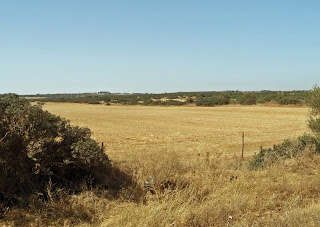Alexander's presence in
North Africa has been limited to Egypt,
which in his days included Cyrene in modern Libya (see: Cyrene,
founded by the Greeks). The king knew of the Phoenician colonies and Carthage further west, but they were not part of his plan then.
My visit to Libya happened later, too, because the
impressive ruins of Leptis Magna are far too Roman to fit into my Alexander picture.
However, the opportunity
to travel to Libya
arose just before the outbreak of the Arab Spring. With hindsight, I've never
been so lucky! Not only because of the timing of my visit but also because it
was here at Leptis Magna that I
really understood what the grandeur of Rome
meant. It is an impression that the ruins of Rome itself cannot give us.
Leptis Magna or
Lepcis Magna is located on the coast of the Mediterranean, 120 km east of Tripoli. It was
founded by the Carthaginians around the 7th century BC at the mouth of the Wadi
Lebda and at the end of the caravan route from the Sahara.
Grain and olive oil were the primary export product, but wild animals from the
hinterland were also traded and shipped.
Carthage was involved in successive fights over the fertile lands of Sicily, facing the locals and the growing
power of Rome. Carthage and Rome fought each other during the three Punic
Wars, which ended with the total destruction of Carthage by the Romans in 146
BC.
Thanks to the generosity
of the local merchants, Leptis Magna already had numerous public buildings
from the time of Augustus and Tiberius (first century AD).
By the end of the second
century, many Africans held high positions in Rome,
and it is said that 15% of the Roman senators came from North
Africa. Emperor Septimius Severus, who ruled from 193 to
211 AD, was born in Leptis Magna,
and he wanted to build a city of imperial allure, a second Rome.
He was an avid
traveler and had visited every corner of his realm, casually crushing a
rebellion here and conquering more land there. He spent the winter of 202-203 here
in Leptis Magna.
Septimius Severus had become wealthy from the goods he had confiscated from his
enemies and could afford to undertake major construction projects. The best
architects and sculptors of the time were brought here to build a new forum and
a huge temple dedicated to the gods protecting the city. The harbor was
expanded, the water supply was improved, and a richly decorated Triumphal Arch put Leptis Magna on
the map. He brought peace and prosperity; the city counted at least 60 to
80,000 inhabitants in his heyday. Septimius Severus could afford some
eccentricity because the population was on his side since he had granted them
the ius italicum, an exemption from local taxes.
Despite all the
prestige, Leptis Magna's days were numbered. The opulence of its people did not sit well with the Roman
aristocracy and created a lot of envy. As a result, most of the African
property was confiscated, and soon decline set in.
The city was seriously
damaged by the earthquake of 262 AD. Emperor Diocletian ( see: Price list established by Emperor Diocletian) tried to restore
order in the 3rd century by promoting Leptis Magna to the capital of the Province
of Tripolitania. Yet,
another devastating earthquake ravaged the city in 306 AD.
With the Fall of the Roman Empire, Tripolitania remained part of the Western Roman Empire, i.e., under Rome's
control, while the Cyrenaica was added to the Eastern Empire, i.e., Constantinople. By that
time, the harbor of Leptis Magna silted up, and the Vandals
moved from Rome
to settle in the area. This definitely sealed the fate of the city.
The Byzantine
Empire took over and constructed the city wall, and many large
buildings were converted into churches. After the Arab invasion in the 7th/8th
century, Leptis Magna was still inhabited. Sadly, the grand city never reached its heyday from the
2nd and 3rd century AD. After the 11th
century, Leptis Magna was abandoned and gradually disappeared into the sand.
However, the magic lived
on, and from the 17th century onward, columns from Leptis Magna found their way to Europe.
Versailles was a destination,
together with the church of St-Germain-des-Prés in Paris. The Temple
of the Gods, built in Windsor Great Park in 1826, has nine
columns from Leptis Magna.
In the 1920s and 1930s,
Italian archaeologists excavated the site extensively, and the most beautiful
artifacts were transferred to the Museum in Tripoli. Sadly, more
recent diggings are at a standstill because of the political instability in Libya.
[Continue reading Leptis Magna or what Rome must have looked like - Part I]



No comments:
Post a Comment